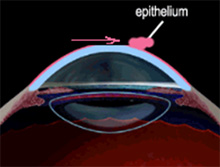What is dry eye syndrome?
Dry eye syndrome is the decline of the quality or quantity of tears bathing the eye. The patient experiences constant pain from eye irritation, and a sandy or gritty sensation that, if untreated, can lead to scarring or ulceration of the cornea, and thus loss of vision.
What do we know about tears?
In many cases, dry eye results from disorders of the various glands which work together to produce normal tears. Tears themselves are a complex combination of substances which form three layers on the eye. The very thin outer layer contains lipids from the meibomian glands in the eyelid, to reduce evaporation. The lacrimal glands produce the middle watery layer that keeps the salinity and the acidity of the tears at proper levels. This middle layer also carries antibodies and other immune defense agents to defend the eye against infection. The inner mucous layer helps the tear film “stick” to the cornea and stay intact.
What causes dry eye syndrome?
Many different things cause dry eye syndrome. The normal aging of tear glands, as well as specific diseases and disorders, may cause changes in the amount and condition of tears produced.
- “Sjِgren’s syndrome,” an immune system disorder characterized by inflammation and dryness of the mouth, eyes, and other mucous membranes, damages the lacrimal glands, and this damage affects tear production.
- Decreased sensitivity of the cornea can also lead to insufficient production of tears. This lack of sensitivity can be brought on by a disease known as “neurotrophic keratitis” as well as by some types of contact lens wear.
- Excessive evaporation of tears can also cause dry eye syndrome. Such evaporation may be caused by “meibomitis,” which results from infection and inflammation of the meibomian glands in the eyelids. People with unusually large eyes, as well as those who suffer from thyroid disease, may also experience dry eye syndrome caused by excessive evaporation.
- Dry eye can also result from unusual facial anatomy or irregularities in the cornea, resulting in uneven or inadequate tear coverage of the eye. Some patients suffer from dry eye as a result of medications such as antibiotics, antihistamines, diuretics, and anti-diarrhoeals, which can dry up the mucous membranes. Hormonal changes can also affect secretions from the tear glands.
Who is affected?
Most of dry eye cases result from normal aging of the glands in the eye, but dry eye can occur at any age. It is estimated that nearly 75% of people over age 65 will experience dry eye syndrome. It occurs in both men and women, although it is most common in women who are pregnant or post-menopausal. Many cases acquire dry eye as a consequence of Sjِgren’s syndrome, and 90% of these patients are women. People suffering from allergies and those wearing contact lenses have greater risk of developing dry eye.
What are the warning signs and how is it detected?
Early signs of dry eye are:
- An occasional burning sensation in the eyes when in areas of low humidity or high pollution.
- A gritty sensation in the eyes which is persistent and painful.
- An inability to cry under emotional stress.
- Decreased tolerance of contact lenses.
- In extreme cases of dry eye, patients may become unusually sensitive to light, experience severe eye pain, or notice diminished vision.
If early signs persist, make an appointment with an ophthalmologist. She or He will check for corneal abrasion or infection and begin treatment to avoid permanent damage.
Can dry eye syndrome come and go?
In the early stages of the disorder, the symptoms it causes may seem to come and go, but these symptoms become more persistent as dry eye worsens. With most forms of dry eye, patients experience greater discomfort as the day progresses. If an infection such as “blepharitis” or “meibomitis” is the cause of dry eye, the discomfort tends to be greatest in the morning, then lessens during the day.
Is dry eye affected by dust, pollen, or tobacco smoke?
Yes. People who are sensitive to pollen, dust or smoke can easily worsen their dry eye condition by exposure to these irritants.
The white of my eye stings most of the time and is red. Could this be dry eye?
Pain and redness of the conjunctiva, which is the coating over the white of the eye, is not necessarily related to dry eye syndrome. It could be the result of an allergic reaction to substances in the air. However, you should have your eyes checked if the irritation persists.
My eyes continually produce excessive tears. Could this be related to dry eye?
Yes. If the dry eye condition is related to the quality, rather than the quantity, of tears, then excessive tears may be produced in response to the irritation. That is, if an essential component of tears is missing, the eye receives little comfort from its tears, and the irritation may continue to stimulate tear production.
How is dry eye treated?
Dry eyes are typically treated by applying artificial tears and ointments. These give temporary relief, but usually do not arrest or reverse damage to the eye.
Dry eye caused by “meibomitis” (the infection and inflammation of oil glands in the eyelids) can be treated with antibiotics such as tetracycline.
Some forms of dry eye benefit from the placement of tiny plugs in the ducts that drain tears from the eye. For severe forms of dry eye, special goggles called “moisture-chamber spectacles” can be worn.
Is there any treatment for corneal scarring?
When patients experience corneal scarring from dry eye, sight may be restored by corneal transplants. However, the original cause of the scarring should be addressed to prevent a recurrence of vision loss.
What can I do to help prevent and cure dry eye syndrome?
- Have annual eye exams.
- See your ophthalmologist immediately if you notice dry eye symptoms or any decline in your vision.











